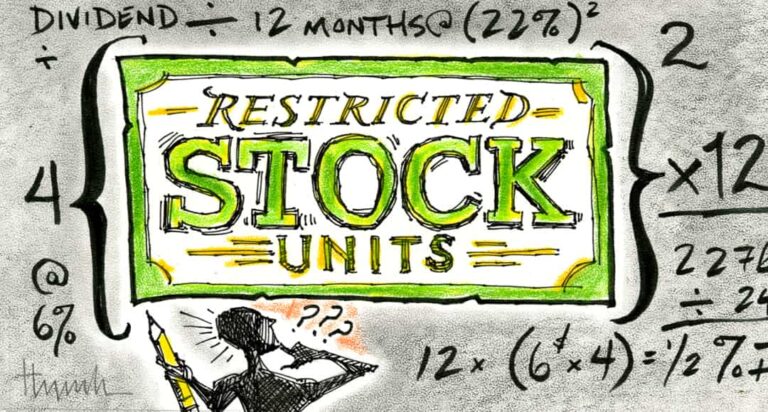
Employees of publicly traded technology companies are familiar with the roller-coaster ride stock prices have been on in recent years.
In 2022, many tech giants watched their stock prices tumble by 40% to 50%, leaving employees with a large stake in company shares and restricted stock units (RSUs) wondering what to do. In addition to seeing drastic drops in net worth, uncertainty about job security also became a real concern. Regret was the overwhelming sentiment.
Fast-forward to 2023, and so far, it’s been a different story. Tech stocks at large have made an impressive comeback. That might present a second chance for those who can still remember how bad they felt after 2022. A second chance is a rare opportunity when it comes to investing and building a financial plan with equity compensation, so there should be some sense of urgency to build a prudent strategy as soon as possible.
How can tech workers use their experience of the last two years to construct a sound financial plan with company stock and RSUs?
When RSUs Vest, a Tax Bill Follows
Let’s start with a simple question: If given a $50,000 bonus, would you use the entirety of it to buy your company’s stock? Reasonable people would likely answer no to that question. Yet tech employees who receive stock as part of their compensation have essentially been doing this every year. That is due to the popularity of the RSU grant.

Most stock compensation we see in the technology sector is in the form of RSUs. When RSU grants turn into vested shares, their market value is immediately taxed as ordinary income. Just like a standard bonus check, employees have no control over the timing or tax withholding on RSUs as they vest. That is why we draw the comparison of RSUs vesting to using an entire bonus to buy company stock.
Most people we encounter have never changed the default option for what to do with their RSUs at vesting. The option we most often see is “sell to cover taxes.” That means a portion of the shares are sold on the vesting day to pay estimated taxes at the federal supplemental wages withholding rate, which is 22% up to $1 million of income and 37% for wages of more than $1 million. In this scenario, the remainder of the money stays in company stock. Over time, if not managed, this can cause a large portion of your overall portfolio to be allocated to company stock.
Owning a piece of the company you work for has many positives. It provides motivation to grow the top line and be more mindful of the bottom line. However, when inaction leads to a concentrated stock position, bad things can happen. As you may have witnessed in 2022, paying taxes on a stock valued at $200 that went down to $100 is frustrating. At the same time, seeing a large portion of your net worth cut in half also hurts.
It’s Tough to Sell When Things Are Going Well
In good times like 2021 and 2023, it is easy to ignore the vesting schedule and keep accumulating the stock. We realize it is very difficult to sell when recent performance is strong. We also realize how bad the regret feels when portfolios drop significantly. The emotional highs and lows of the stock market are only intensified when a high percentage of your portfolio is in one stock.
In the financial planning profession, we refer to this as concentration risk, which is the risk of owning too much of a single stock or sector. Concentration can result in a fast track to wealth creation or wealth destruction. Without a plan, you won’t know if or how this risk can impact you.
As a reminder, your total company stock holdings include the shares you own, your expected paychecks, and future invested shares.
Instead of the old-school method of spending a lot of time trying to predict the future financial prospects of a company to determine whether you should buy, sell, or hold, planners will use a disciplined decision-making process to help decide what amount of company stock is prudent for your plan.
Whatever Your Goal, Make Informed Decisions

If your sole goal is to become fabulously wealthy, concentrated bets are a potential option. However, you risk losing it all. If your goal is to live a financially independent lifestyle, you would likely decide to strategically diversify your portfolio to avoid potential calamity. That strategy comes with the downside of giving up the chance of future significant outperformance. The key is to have a discussion, model projected outcomes, and make an informed decision for your situation.
Company stock can present an incredible opportunity to improve your financial plan. If 2022 put a strain on your investment portfolio, here are some financial planning strategies you can consider to improve future outcomes:
Create an investment purpose by putting goals and vision in the driver’s seat.
It’s hard to position your money and investments if you do not have a purpose for them. Determine where you are and where you want to go. Then, you can better understand how your company stock fits (or doesn’t fit) into your overall investment plan. You can’t control the performance of your company stock, but you can control how you invest your money.
Be tax-efficient when trimming your stock portfolio.
Whether it has fallen in value or is highly appreciated, pay attention to what shares you sell. Your various lots of shares will have different cost bases, which determine the amount you’re taxed for capital gains. You want to sell shares in a tax-smart manner.
For example, if you sell the lowest basis shares at a gain, you might increase your tax bill. On the flip side, you might have an opportunity to harvest losses on some high-basis shares. It’s important to discuss this with your tax and financial adviser to make sure you’re maximizing after-tax proceeds when selling shares.
Consider selling future RSUs at vesting.
As new shares vest, sell them. Use those dollars to fund important goals or move them into a diversified investment allocation. We have found this balanced approach to be one of the better behavioral ways to reduce concentration risk. If your company stock takes off, your current shares will benefit, and future vesting amounts will be larger, but you’ve also taken action to lower your exposure.
That won’t be an instant way to diversify, but it may gradually reduce concentration. Whether or not you hold a large position in company stock, this can be a reasonable strategy with RSUs.
Be proactive, not reactive.
Don’t decide what to do after RSUs vest. Without a proactive game plan, you’re likely to take no action and hold the shares. Create a plan for the RSUs before vesting. Maybe you want to supplement future wealth flexibility, top off the children’s education accounts, start a travel fund or do some home updates. Not every dollar has to go into a long-term investment.
Prioritize your goals and determine how your RSUs can help fund or even accelerate those goals. Set calendar reminders on vesting dates to make sure you take some type of action.
Get help from a financial planner who specializes in equity!
Most of the time, you already know what you need to do but don’t have the accountability or the ability to craft a plan with your equity. If this sounds like you, seek out a CFP® professional who specializes in equity compensation.
Editor’s Note: This article was originally published on Kiplinger in collaboration with Travis Gatzemeier of Kenetix.
Disclosure: The information provided is for educational and informational purposes only and does not constitute investment advice and it should not be relied on as such. It should not be considered a solicitation to buy or an offer to sell a security. It does not take into account any investor’s particular investment objectives, strategies, tax status or investment horizon. You should consult your attorney or tax advisor.
Authors
-

Kevin Caldwell is a principal at Golden Road Advisors and a CERTIFIED FINANCIAL PLANNER™ (CFP®️) practitioner with over 15 years of experience in the financial services industry. In addition to providing advice and guidance to clients, he regularly contributes to publications such as Kiplinger, Yahoo! Finance, Dalbar, and MarketWatch.
View all posts -

Travis Gatzemeier is a CERTIFIED FINANCIAL PLANNER™ (CFP®️) practitioner and founder of Kinetix Financial Planning. Travis specializes in helping growth-minded entrepreneurs and equity-compensated professionals build financial flexibility and reduce taxes. He has been in the financial services industry since 2010 and has been recognized as a top 100 financial adviser by Investopedia.
View all posts



